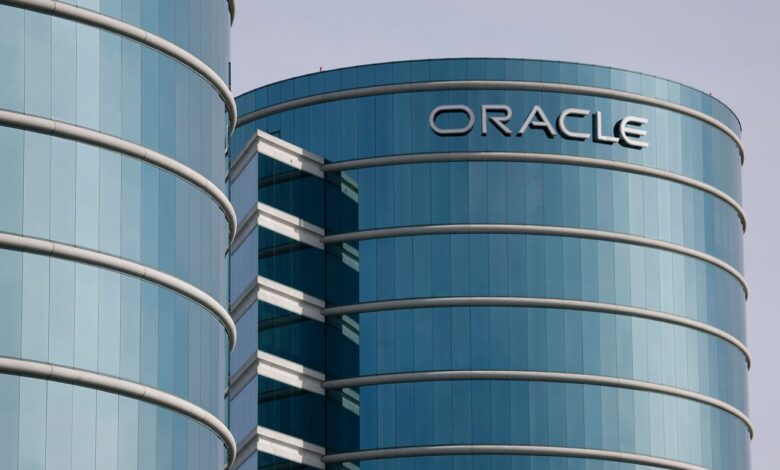Buy Or Fear Oracle Stock At $220?

📝 usncan Note: Buy Or Fear Oracle Stock At $220?
Disclaimer: This content has been prepared based on currently trending topics to increase your awareness.
REDWOOD SHORES, CALIFORNIA – MARCH 10: The Oracle logo is displayed on a building at an Oracle campus on March 10, 2025 in Redwood Shores, California. Oracle will report third quarter earnings today after the closing bell. (Photo by Justin Sullivan/Getty Images)
Getty Images
Last week, Oracle stock (NYSE: ORCL) fell 5%, aligning with a broader pullback in several AI-related names. The decline was driven by worries about a potential bubble in the space, especially given the substantial capital spending underway. Even so, Oracle has been performing strongly, supported by rising demand for its cloud services, and the shares have remained up over 60% over the past twelve months.
Given this recent softness—with the stock down about 10% over a month—the key question for investors is whether ORCL is a buy or a sell. We recently shared an analysis on the potential downside for Oracle stock if the market turns, and we continue to believe upside looks limited. While we don’t see any issues with the company’s core business, the current valuation appears quite rich.
Our view stems from comparing ORCL’s present valuation with its recent operating trajectory and its historical and current financial profile. Evaluating Oracle across Growth, Profitability, Financial Stability, and Downturn Resilience suggests the company retains a strong operating and financial base, as summarized below.
That said, if you want upside with less volatility than a single name, consider the High Quality Portfolio. It has comfortably outpaced its benchmark—a blend of the S&P 500, Russell, and S&P MidCap indexes—and has delivered returns exceeding 91% since inception. Separately, see – SoundHound AI: After 6x Gains, What’s Next For SOUN Stock?
How Does Oracle’s Valuation Look vs. The S&P 500?
Going by what you pay per dollar of sales or profit, ORCL stock looks very expensive compared to the broader market.
- Oracle has a price-to-sales (P/S) ratio of 11.1 vs. a figure of 3.3 for the S&P 500
- And, it has a price-to-earnings (P/E) ratio of 51.0 vs. the benchmark’s 24.0
How Have Oracle’s Revenues Grown Over Recent Years?
Oracle’s Revenues have shown growth in recent years.
- Oracle has seen its top line grow at an average rate of 10.7% over the last 3 years (vs. an increase of 5.3% for the S&P 500)
- Its revenues have grown 8.4% from $53 Bil to $57 Bil in the last 12 months (vs. growth of 5.1% for the S&P 500)
- Also, its quarterly revenues grew 11.3% to $16 Bil in the most recent quarter from $14 Bil a year ago (vs. 6.1% improvement for the S&P 500)
How Profitable Is Oracle?
Oracle’s profit margins are considerably higher than most companies in the Trefis coverage universe.
- Oracle’s Operating Income over the last four quarters was $18 Bil, which represents a considerably high Operating Margin of 31.5% (vs. 18.6% for the S&P 500)
- Oracle’s Operating Cash Flow (OCF) over this period was $21 Bil, pointing to a considerably high OCF Margin of 36.3% (vs. 20.2% for the S&P 500)
- For the last four-quarter period, Oracle’s Net Income was $12 Bil – indicating a high Net Income Margin of 21.7%(vs. 12.7% for the S&P 500)
Does Oracle Look Financially Stable?
Oracle’s balance sheet looks strong.
- Oracle’s Debt figure was $104 Bil at the end of the most recent quarter, while its market capitalization is $635 Bil (as of 9/1/2025). This implies a very strong Debt-to-Equity Ratio of 16.4% (vs. 20.3% for the S&P 500). [Note: A low Debt-to-Equity Ratio is desirable]
- Cash (including cash equivalents) makes up $11 Bil of the $168 Bil in Total Assets for Oracle. This yields a moderate Cash-to-Assets Ratio of 6.7% (vs. 7.2% for the S&P 500)
How Resilient Is ORCL Stock During A Downturn?
ORCL stock has been more resilient than the benchmark S&P 500 index during some of the recent downturns. Worried about the impact of a market crash on ORCL stock? Our dashboard – ORCL Down 5.9% In A Day. How Confident Are You In The Stock? – has a detailed analysis of how the stock performed during and after previous market crashes.
Inflation Shock (2022)
- ORCL stock fell 41.1% from a high of $103.65 on 15 December 2021 to $61.07 on 30 September 2022, vs. a peak-to-trough decline of 25.4% for the S&P 500
- The stock fully recovered to its pre-Crisis peak by 25 May 2023
- Since then, the stock has increased to a high of $256.43 on 6 August 2025 and currently trades at around $225
Covid Pandemic (2020)
- ORCL stock fell 28.6% from a high of $55.73 on 12 February 2020 to $39.80 on 12 March 2020, vs. a peak-to-trough decline of 33.9% for the S&P 500
- The stock fully recovered to its pre-Crisis peak by 2 July 2020
Global Financial Crisis (2008)
- ORCL stock fell 41.1% from a high of $23.52 on 8 August 2008 to $13.85 on 9 March 2009, vs. a peak-to-trough decline of 56.8% for the S&P 500
- The stock fully recovered to its pre-Crisis peak by 18 December 2009
Putting All The Pieces Together: What It Means For ORCL Stock
In summary, Oracle’s performance across the parameters detailed above are as follows:
• Growth: Strong
• Profitability: Very Strong
• Financial Stability: Strong
• Downturn Resilience: Strong
• Overall: Strong
Overall, Oracle has executed well on the metrics we assessed, which is reflected in its high valuation of 11 times trailing revenue. This stands well above its three-year average price-to-sales multiple of 6 times revenue. Given that elevated 11x figure, the stock screens relatively expensive, supporting our view that ORCL is a costly purchase at present.
Of course, we could be wrong, and some investors may be willing to pay an even richer multiple for Oracle. That could reflect the company’s strong projected revenue growth through 2029 and its past resilience in downturns. Still, at 11x, we think much of that optimism is already embedded.
See, there always remains a meaningful risk when investing in a single, or just a handful of stocks. Consider the Trefis High Quality (HQ) Portfolio, which, with a collection of 30 stocks, has a track record of comfortably outperforming the S&P 500 over the last 4-year period. Why is that? As a group, HQ Portfolio stocks provided better returns with less risk versus the benchmark index; less of a roller-coaster ride, as evident in HQ Portfolio performance metrics.




